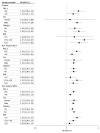Long-Term Body Mass Index Variability and Adverse Cardiovascular Outcomes
- PMID: 38512255
- PMCID: PMC10958234
- DOI: 10.1001/jamanetworkopen.2024.3062
Long-Term Body Mass Index Variability and Adverse Cardiovascular Outcomes
Abstract
Importance: Body mass index (BMI; calculated as weight in kilograms divided by height in meters squared) is a commonly used estimate of obesity, which is a complex trait affected by genetic and lifestyle factors. Marked weight gain and loss could be associated with adverse biological processes.
Objective: To evaluate the association between BMI variability and incident cardiovascular disease (CVD) events in 2 distinct cohorts.
Design, setting, and participants: This cohort study used data from the Million Veteran Program (MVP) between 2011 and 2018 and participants in the UK Biobank (UKB) enrolled between 2006 and 2010. Participants were followed up for a median of 3.8 (5th-95th percentile, 3.5) years. Participants with baseline CVD or cancer were excluded. Data were analyzed from September 2022 and September 2023.
Exposure: BMI variability was calculated by the retrospective SD and coefficient of variation (CV) using multiple clinical BMI measurements up to the baseline.
Main outcomes and measures: The main outcome was incident composite CVD events (incident nonfatal myocardial infarction, acute ischemic stroke, and cardiovascular death), assessed using Cox proportional hazards modeling after adjustment for CVD risk factors, including age, sex, mean BMI, systolic blood pressure, total cholesterol, high-density lipoprotein cholesterol, smoking status, diabetes status, and statin use. Secondary analysis assessed whether associations were dependent on the polygenic score of BMI.
Results: Among 92 363 US veterans in the MVP cohort (81 675 [88%] male; mean [SD] age, 56.7 [14.1] years), there were 9695 Hispanic participants, 22 488 non-Hispanic Black participants, and 60 180 non-Hispanic White participants. A total of 4811 composite CVD events were observed from 2011 to 2018. The CV of BMI was associated with 16% higher risk for composite CVD across all groups (hazard ratio [HR], 1.16; 95% CI, 1.13-1.19). These associations were unchanged among subgroups and after adjustment for the polygenic score of BMI. The UKB cohort included 65 047 individuals (mean [SD] age, 57.30 (7.77) years; 38 065 [59%] female) and had 6934 composite CVD events. Each 1-SD increase in BMI variability in the UKB cohort was associated with 8% increased risk of cardiovascular death (HR, 1.08; 95% CI, 1.04-1.11).
Conclusions and relevance: This cohort study found that among US veterans, higher BMI variability was a significant risk marker associated with adverse cardiovascular events independent of mean BMI across major racial and ethnic groups. Results were consistent in the UKB for the cardiovascular death end point. Further studies should investigate the phenotype of high BMI variability.
Conflict of interest statement
Figures
References
-
- Powell-Wiley TM, Poirier P, Burke LE, et al. ; American Heart Association Council on Lifestyle and Cardiometabolic Health; Council on Cardiovascular and Stroke Nursing; Council on Clinical Cardiology; Council on Epidemiology and Prevention; and Stroke Council . Obesity and cardiovascular disease: a scientific statement from the American Heart Association. Circulation. 2021;143(21):e984-e1010. doi:10.1161/CIR.0000000000000973 - DOI - PMC - PubMed
Publication types
MeSH terms
Substances
Grants and funding
LinkOut - more resources
Full Text Sources
Medical
Miscellaneous



